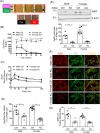Tubular Deficiency of Heterogeneous Nuclear Ribonucleoprotein F Elevates Systolic Blood Pressure and Induces Glycosuria in Mice
- PMID: 31673025
- PMCID: PMC6823451
- DOI: 10.1038/s41598-019-52323-1
Tubular Deficiency of Heterogeneous Nuclear Ribonucleoprotein F Elevates Systolic Blood Pressure and Induces Glycosuria in Mice
Abstract
We reported previously that overexpression of heterogeneous nuclear ribonucleoprotein F (Hnrnpf) in renal proximal tubular cells (RPTCs) suppresses angiotensinogen (Agt) expression, and attenuates systemic hypertension and renal injury in diabetic Hnrnpf-transgenic (Tg) mice. We thus hypothesized that deletion of Hnrnpf in the renal proximal tubules (RPT) of mice would worsen systemic hypertension and kidney injury, perhaps revealing novel mechanism(s). Tubule-specific Hnrnpf knockout (KO) mice were generated by crossbreeding Pax8-Cre mice with floxed Hnrnpf mice on a C57BL/6 background. Both male and female KO mice exhibited elevated systolic blood pressure, increased urinary albumin/creatinine ratio, tubulo-interstitial fibrosis and glycosuria without changes in blood glucose or glomerular filtration rate compared with control littermates. However, glycosuria disappeared in male KO mice at the age of 12 weeks, while female KO mice had persistent glycosuria. Agt expression was elevated, whereas sodium-glucose co-transporter 2 (Sglt2) expression was down-regulated in RPTs of both male and female KO mice as compared to control littermates. In vitro, KO of HNRNPF in human RPTCs (HK-2) by CRISPR gRNA up-regulated AGT and down-regulated SGLT2 expression. The Sglt2 inhibitor canagliflozin treatment had no effect on Agt and Sglt2 expression in HK-2 and in RPTCs of wild-type mice but induced glycosuria. Our results demonstrate that Hnrnpf plays a role in the development of hypertension and glycosuria through modulation of renal Agt and Sglt2 expression in mice, respectively.
Conflict of interest statement
The authors declare no competing interests.
Figures






References
-
- Ingelfinger JR, Zuo WM, Fon EA, Ellison KE, Dzau VJ. In situ hybridization evidence for angiotensinogen messenger RNA in the rat proximal tubule. An hypothesis for the intrarenal renin angiotensin system. The Journal of clinical investigation. 1990;85:417–423. doi: 10.1172/jci114454. - DOI - PMC - PubMed
Publication types
MeSH terms
Substances
Grants and funding
LinkOut - more resources
Full Text Sources
Medical
Molecular Biology Databases
Research Materials
Miscellaneous

